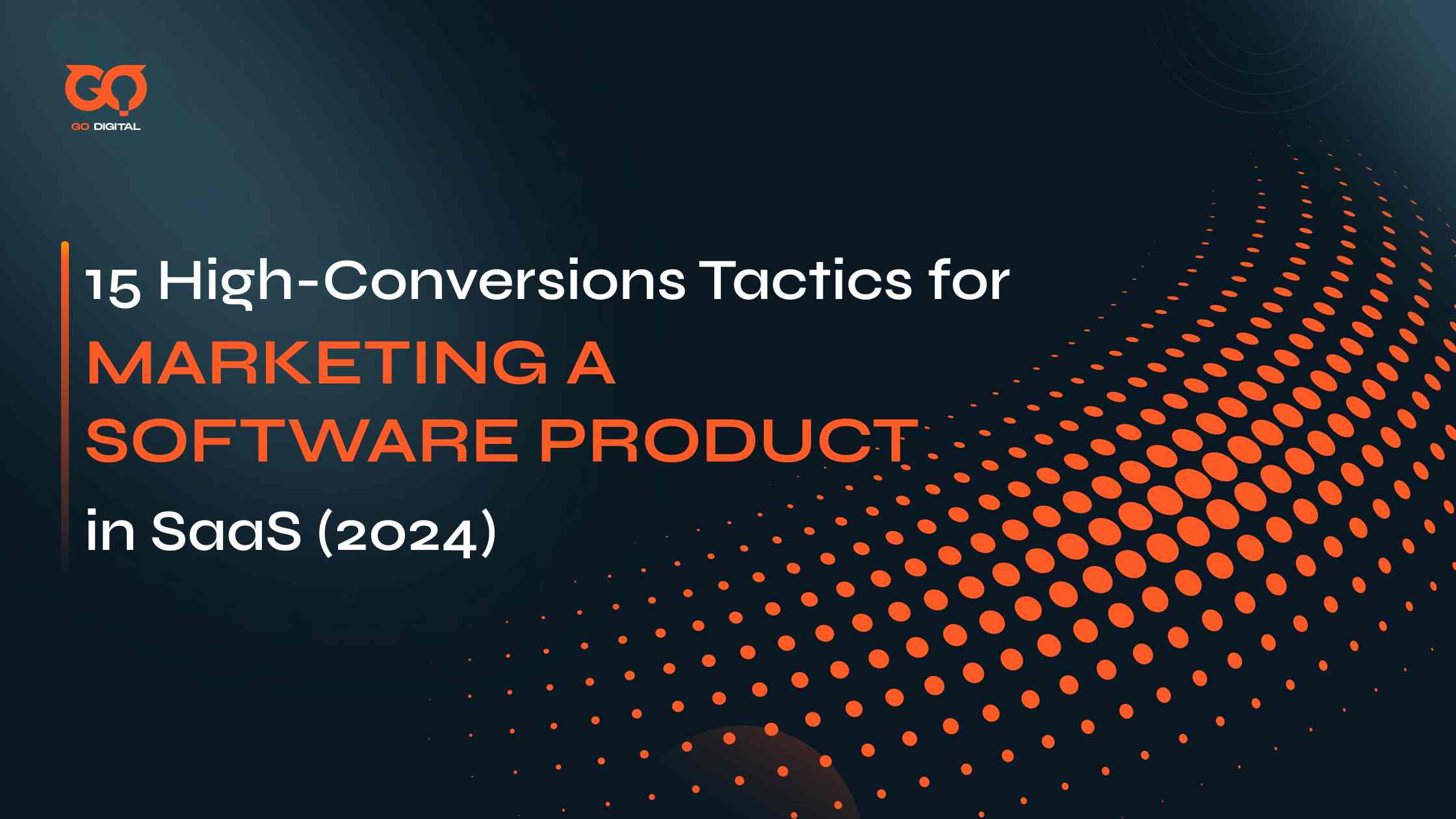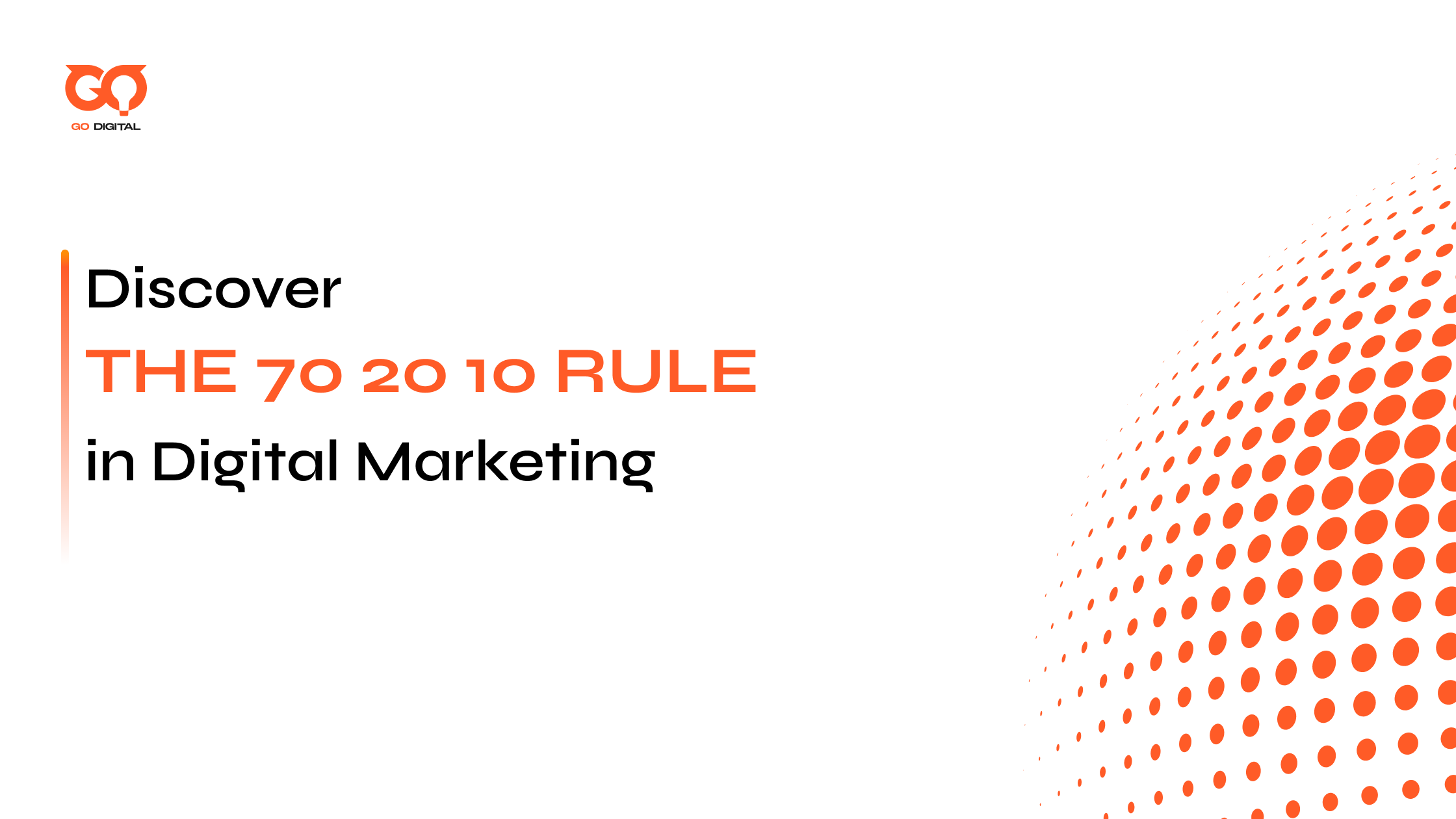Bringing a physical product to market, promoting it, and driving sales for it is already a challenging task for any marketer. Now, what if you’re tasked to do all that for something intangible—in this case, a software? It might seem strange at first, like trying to sell a promise and hoping people will buy into it.
But it doesn’t have to be a shot in the dark. Marketing a software product, like any other marketing strategies, will also have tactics and frameworks that can be adaptable in the SaaS world.
In this article, we’ll cover the basics of SaaS product marketing, explore what a typical software marketing strategy looks like, and dive into some of the most effective tactics that have been proven to work across the industry.
With no further ado, let’s start!
What Is SaaS Product Marketing?
SaaS (Software-as-a-Service) product marketing is the process of promoting and selling subscription-based software to the target audience through key channels, such as content, SEO, and email strategies.

Research by DemandSage shows that over 70% of companies globally use at least one SaaS application, with larger companies often managing more than 100 different SaaS tools.
With so many businesses adopting SaaS, the competition is fierce. In the U.S. alone, there were over 15,000 SaaS companies in 2023, making it crucial for marketers to use smart strategies to stand out in this crowded market.
In such a competitive market, success depends on effective SaaS product marketing, using tried-and-true strategies along with well-crafted planning to build customer relationships and fuel growth.
How Marketing a Software Product is Different From Traditional Product Marketing
Marketing a SaaS product is a whole different ball game compared to traditional product marketing.
SaaS products rely on a timely subscription-based structure, so the focus isn’t just on making a sale—it’s about building a long-term relationship with the customer base. Marketers need to show the software’s ongoing value to keep customers hooked month after month, year after year.
The customer acquisition process in SaaS marketing is more complex, as it aligns with a longer customer journey that includes stages like awareness, trial, conversion, and retention. Unlike traditional products, where the journey often ends at purchase, SaaS marketers need to ensure customers stick around through each stage and continue finding value in the product.
Plus, because SaaS products are intangible, you can’t rely on flashy packaging or physical presence to make a sale.
Well, sure, eye-catching UX/UI or website designs are fundamental to keep users engaged, but the main point here is the marketing needs to be crystal clear about how the software solves real problems. Demos, success stories, and testimonials become your best tools to show potential users that this isn’t just software—it’s a solution they didn’t know they needed.
5 Steps to Build a Marketing Plan For Software Products
Step 1. Always start with market research
Before diving into anything, you need to understand the landscape you’re stepping into, and research to the point that you understand it like the back of your hand.
Gather data on industry trends, customer pain points, and what your competitors are up to. This research lays the foundation for everything that follows—think of it as your marketing GPS to guide your way through building the master plan.
Step 2. Define your target customer
Quite frankly, you can’t sell to everyone. Instead, zero in on who your ideal customers are. Create detailed profiles that capture their needs, challenges, and buying habits.
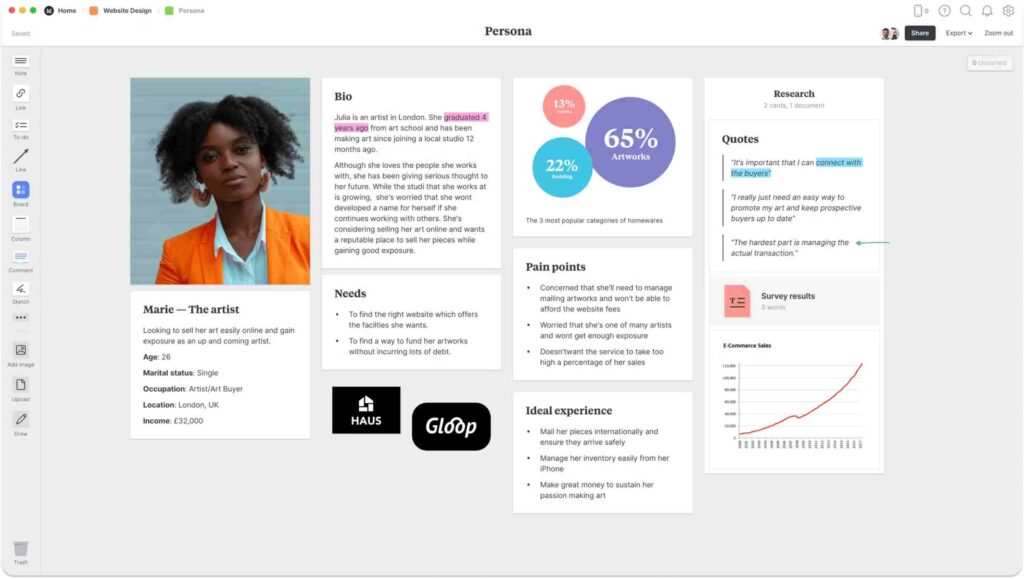
Step 3. Find Your Unique Spot
What makes your software stand out in a crowded market? Your unique offerings, of course.
This is where you define your value proposition—what you offer that no one else does. Positioning is all about carving out that unique space in your customers’ minds where your product solves their problems better than anything else out there.
To make your positioning process smoother, consider using the Value Proposition Canvas. It’s a straightforward tool that helps you match what your product offers with what your customers really need. Here’s how to use it:
- Customer Profile: Start by mapping out your target customer’s jobs (tasks they need to get done), pains (challenges they face), and gains (benefits they want).
- Value Map: On the other side, outline your product’s features and how they either relieve those pains or create those gains.
- Fit: The goal is to align your product’s value directly with your customer’s needs. The closer the fit, the stronger your value proposition.
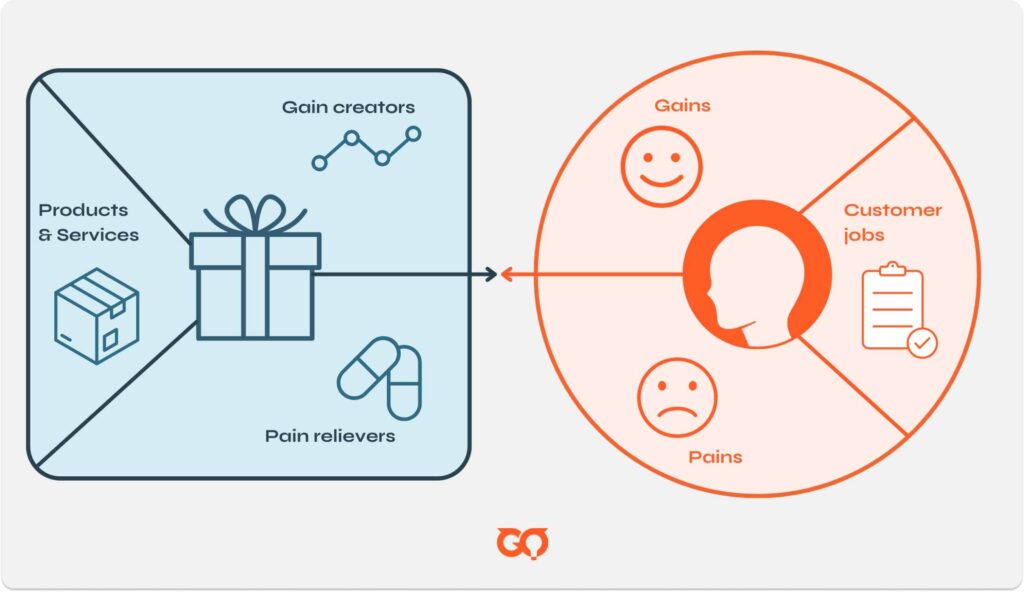
Step 4. Plan the Market Strategy
Now that you know who you’re targeting and how you stand out, it’s time to decide how to reach them.
To effectively reach your target audience, consider using the Bullseye Framework, developed by Gabriel Weinberg. This approach helps you identify the most impactful marketing channels by testing different options and narrowing down to the ones that drive the best results.
1. Brainstorm
Start by listing all possible marketing channels that you can think of if you’re not bound to the limit of budget and everything else. You can go from content marketing to social media, email campaigns, and beyond. Think creatively about where your audience might be and draft out every possible channel.
2. Rank and Prioritize
Organize these channels into three rings:
- Outer Ring (long shots): Channels that might work but are uncertain or less likely,
- Middle Ring (promising): Channels that have potential but require testing,
- Bullseye (most likely to succeed): Channels that you believe have the highest likelihood of success.
Prioritize the ones you believe will have the highest impact based on your knowledge and research.
3. Test channels in Middle Ring
Conduct small, inexpensive experiments in the channels you’ve identified in the Middle Ring. The goal is to gather data and insights to see which channels perform the best without investing too heavily upfront.
4. Focus on the Bullseye: Once you’ve identified the best-performing channels from your tests, focus your efforts and resources on these channels. The Bullseye channels are where you’ll get the most traction and should become the core of your marketing strategy.

Step 5. Set a Budget and Track Your Metrics
Money talks, and so do numbers. Figure out how much you’re going to spend and where. More importantly, decide how you’ll measure success.
Set clear KPIs to monitor your progress and be ready to tweak your plan as you go. After all, even the best-laid plans need a little adjustment from time to time.
15 Effective Marketing Tactics for Software Products in 4 Strategic Phases
When it comes to marketing a software product, guide your potential customers through different phases of their journey—from first discovering your product to becoming loyal users.
Here’s a breakdown of high-conversion tactics, organized by the phases of Awareness, Adoption, Engagement, and Retention & Growth:
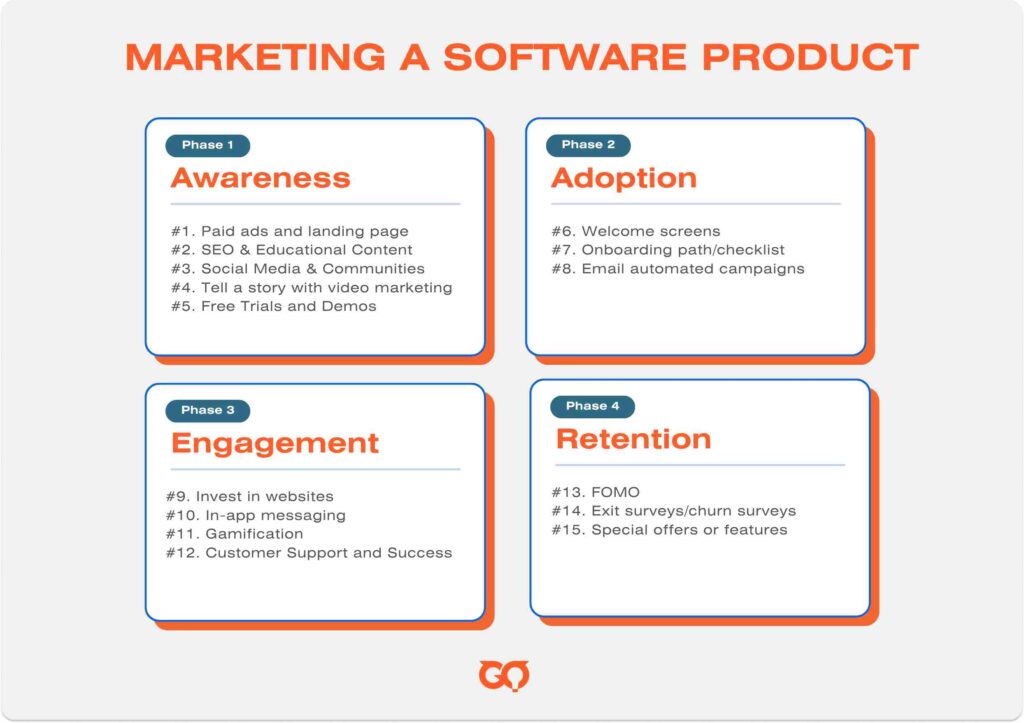
Phase 1: Awareness
The goal in this phase is to get your software in front of as many eyes as possible, and make sure those eyes belong to the right people.
#1. Paid ads and landing page
Use targeted paid ads on platforms like Google and social media to attract potential customers. Drive them to a well-designed landing page that clearly explains your software’s value proposition and encourages them to take the next step.
#2. SEO & Educational Content
Focus on SEO to make sure your content gets noticed by the right people. Create helpful resources like blogs, guides, and tutorials that tackle your audience’s real problems.
Don’t forget to show how your software can solve their issues in those blogs, you’ll not only drive more traffic but also build credibility and trust with potential customers.
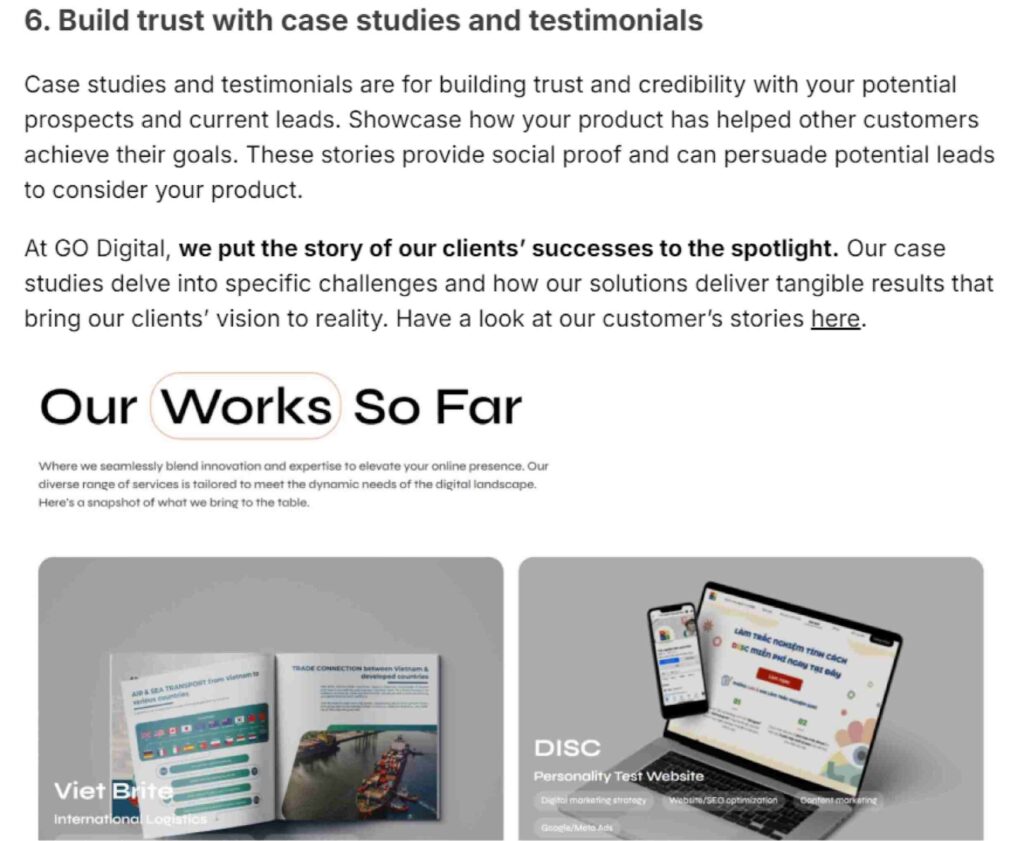
#3. Social Media & Communities
Use social media and online communities where your audience already hangs out. Share content that’s genuinely useful, get involved in conversations, and start building a community around your brand.
The goal is to create a loyal group of followers who engage with your content and spread the word about your product.
#4. Tell a story with video marketing
Use video to share your brand’s story, simplify complex features, or showcase how customers succeed with your product. Videos are highly engaging and can significantly boost your visibility and conversions.
Canva is a great example of how to do this on YouTube. They’ve created a variety of video content, from tutorials on making videos and managing teams to industry-specific tips for developers and nonprofits, showing how their product can work for everyone.
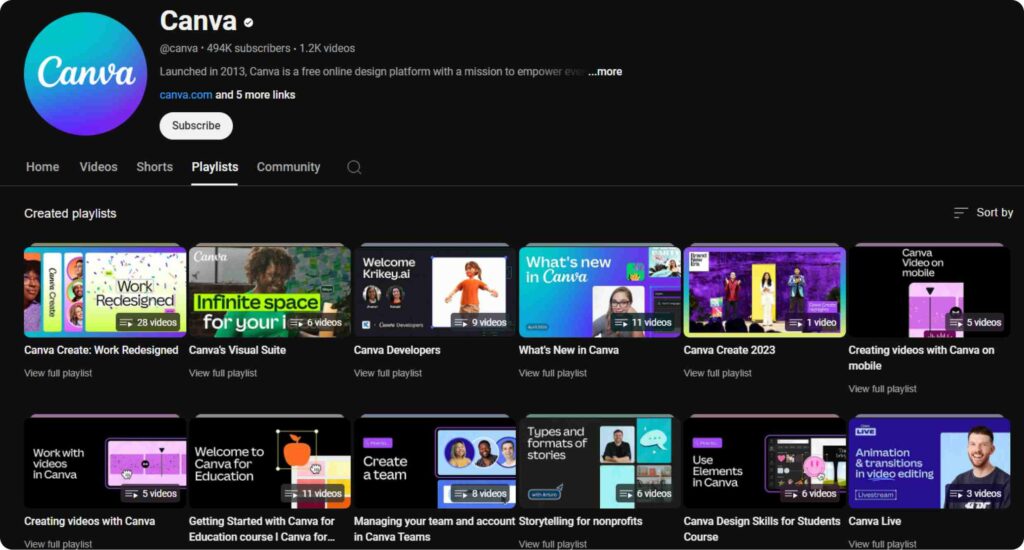
They don’t just sell a product; they show how that product can fit into and improve various aspects of their users’ lives. By addressing specific needs and interests, they make their content relevant and useful, which naturally boosts engagement.
And of course, in every video’s description box, they add a CTA to boost their user adoption!
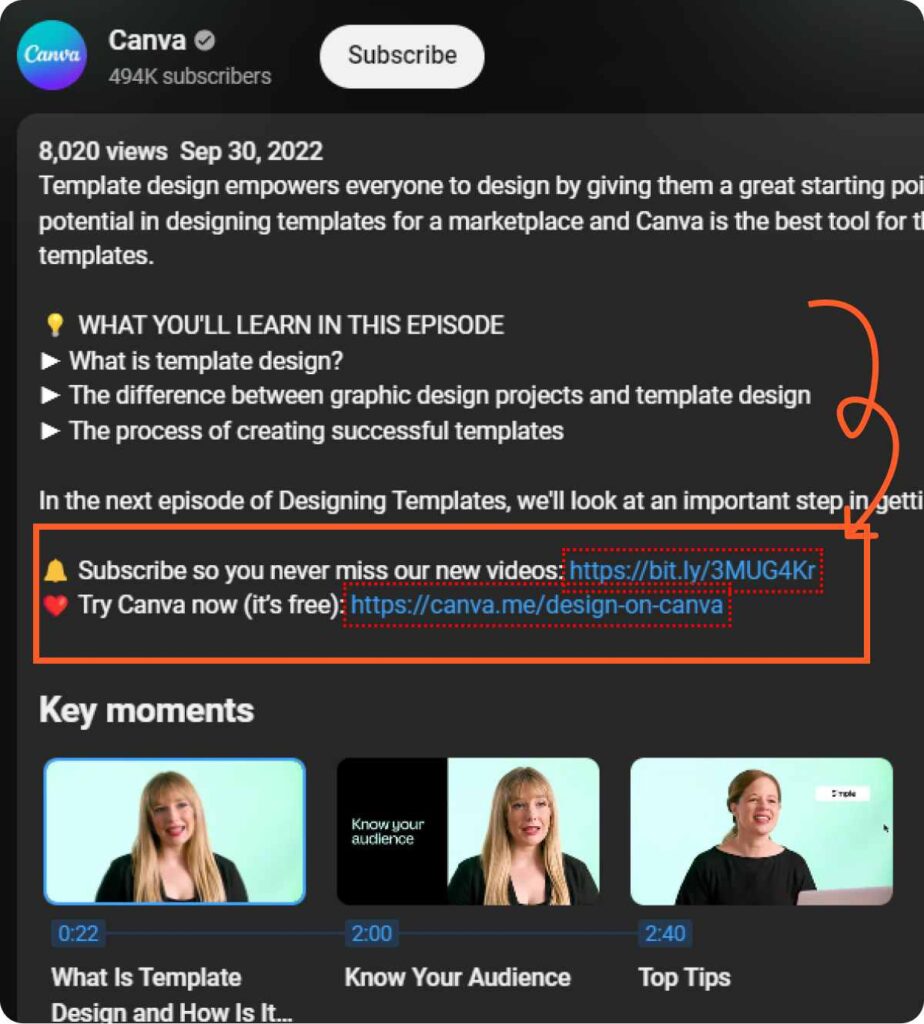
How about the brand’s story? Shopify has supported countless entrepreneurs to do just that, providing the tools and platform to build their businesses. Every so often, Shopify “flips the script” and becomes the storyteller, sharing their journey along with the new generation of entrepreneurs.
#5. Free Trials and Demos
Offer free trials or demos to let potential customers experience your software firsthand. This is one of the oldest but effective ways to move them from curiosity to consideration.
Spotify always encourages users to try out Premium, but they sweeten the deal by offering a 1-month trial, giving users a chance to experience the ad-free listening they’ve always been promoting during those 30-second music ad breaks. (Smart, isn’t it?)
This trial period often converts curious listeners into paying customers, as they get hooked on the perks of Premium. Fyi, it’s called a freemium strategy—offering the core product for free while enticing users to upgrade by showcasing the benefits of the premium version.
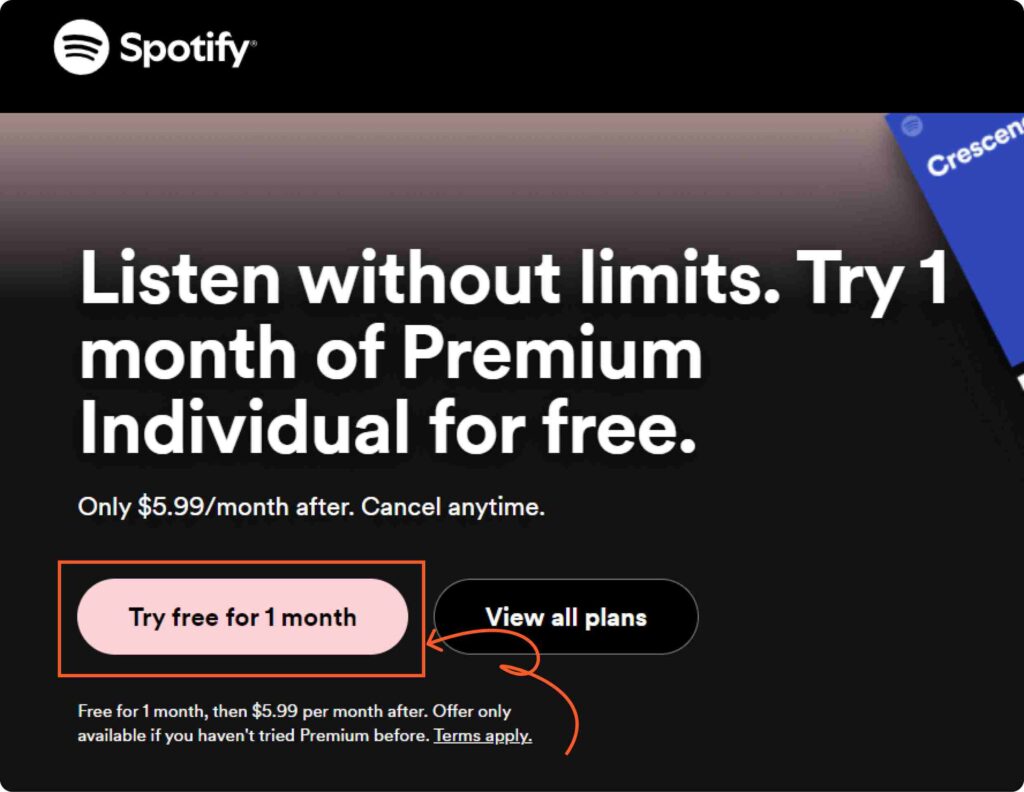
Phase 2: Adoption
Once you’ve captured their interest, the next step is to ensure that users start using your product and see its value quickly.
#6. Welcome screens
Use personalized welcome screens to segment users based on their personas. Usually, you’ll have around 3-4 questions for your customers to answer about themselves, like how Grammarly is doing their surveys below. This helps tailor the onboarding process to meet their specific needs.
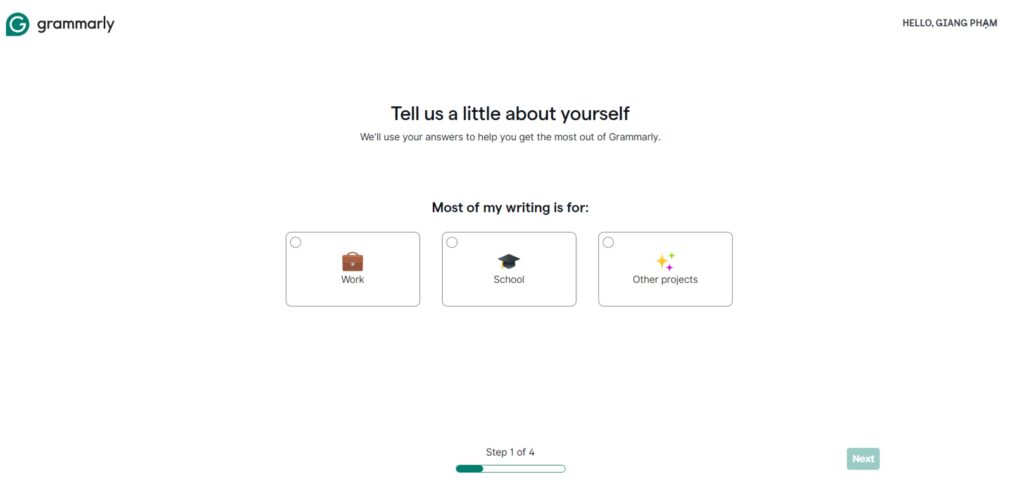
#7. Onboarding path/checklist
Design an onboarding path or checklist to guide new users a complete tour through key features. A smooth onboarding experience increases the chances of users sticking with your product.
#8. Email automated campaigns
Set up automated email campaigns to nurture users through the adoption phase. These emails can offer tips, highlight features, and encourage users to explore more of your product.
A great way to get comfortable with SaaS email automation is by exploring Mailmodo’s SaaS email sequences. They offer a range of templates, from welcome sequences to product adoption and churn prevention, making it easy to find the right flow for your needs.
Phase 3: Engagement
Engagement is about keeping users actively using your software and finding ongoing value.
#9. Invest in websites
Ensure your website is a resource hub for users, offering everything from knowledge bases to forums. A well-maintained website can serve as a go-to for both prospects and current users.
#10. In-app messaging to announce new update
Use in-app messaging to inform users about new features, updates, or tips. Keeping users in the loop fosters a sense of connection and encourages continued use.
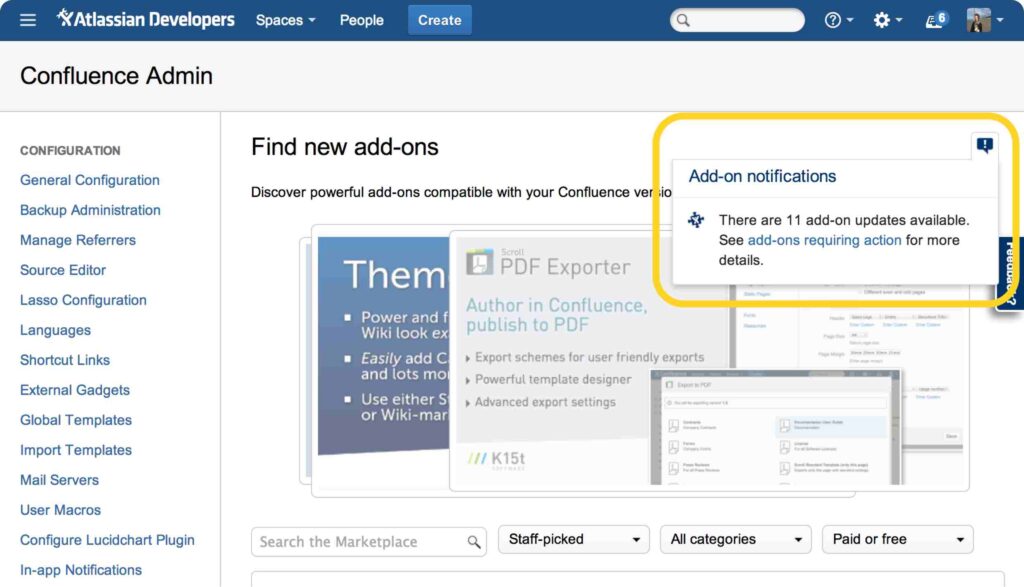
#11. Gamification
Introduce gamification elements, like achievements or progress bars, to make using your software more engaging and rewarding. This can boost user interaction and satisfaction.
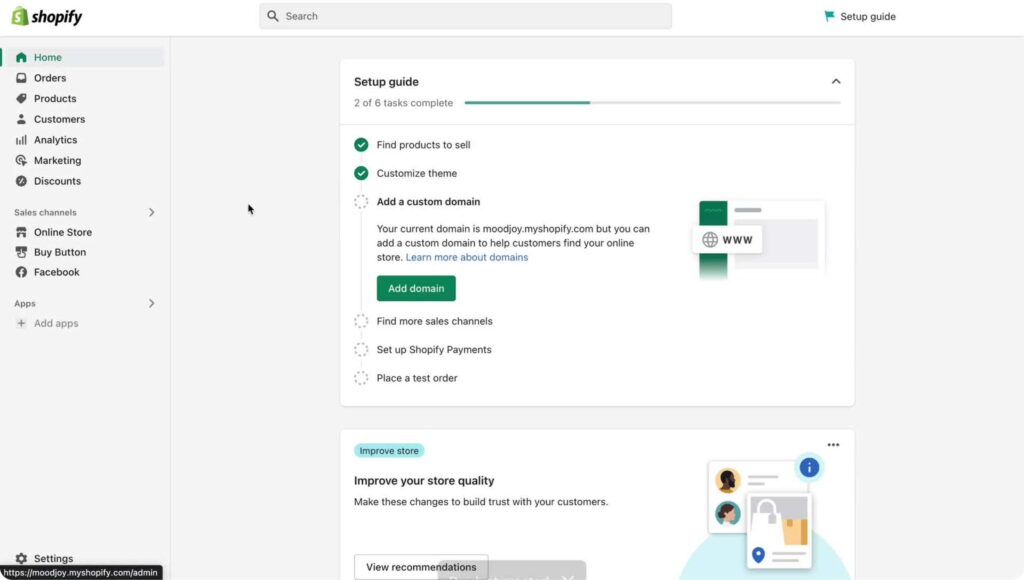
#12. Customer Support and Success
Provide stellar customer support and have a customer success team to proactively help users achieve their goals with your software.
You can try implementing in-app support like chatbots or messaging systems so that users can get help without leaving the platform, and personalizing your customer success efforts by using data to tailor interactions.
Phase 4: Retention & Growth
The final phase focuses on keeping users long-term and encouraging them to expand their use of your product.
#13. FOMO
Create a sense of FOMO (Fear of Missing Out) by showcasing what additional features or benefits users can access by upgrading their plan. Highlighting success stories or case studies can be effective here.
#14. Exit surveys/churn surveys
When users leave, use exit or churn surveys to understand why they want to leave the app, whether it’s due to missing features, pricing issues, or something else to find out.
This feedback is gold. It gives you clear insights into where your product might be falling short and what changes you can make to keep others from leaving. Addressing these issues not only helps improve your service but also boosts customer retention in the long run.
But there’s more—you can turn these insights into immediate action. If users select a scripted reason for leaving, you can guide them on a journey to fix their issue right away and avoid them leaving completely.
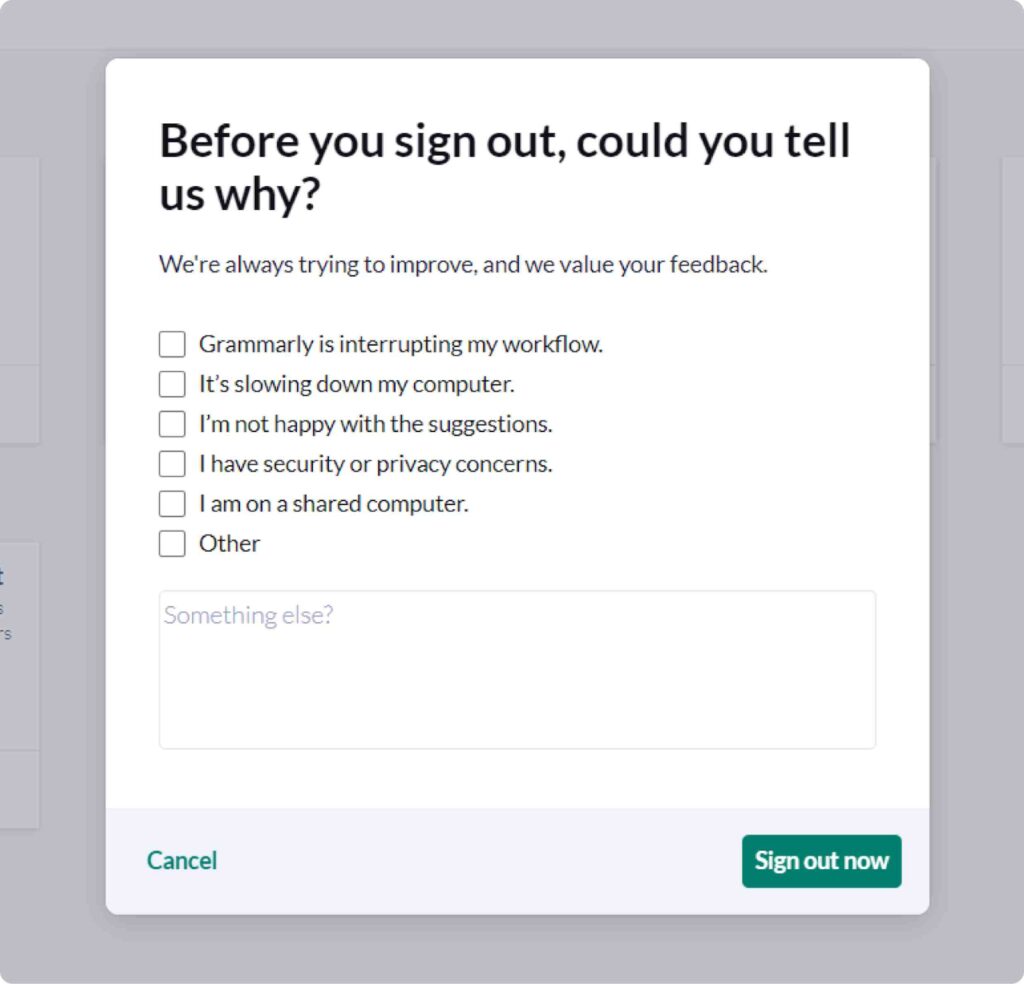
#15. Special offers or features
Offer special deals, loyalty rewards, or early access to new features to keep users engaged and feeling valued. These perks can drive retention and encourage users to stay with your product longer.
The Key Takeaways
Marketing a software product in SaaS is about understanding your unique challenges and applying practical, effective strategies. With a clear plan and targeted tactics for each phase of the customer lifecycle, you can successfully attract, engage, and retain users.
This approach helps build strong customer relationships and drives sustainable growth, ensuring your software product stands out in a competitive market.
Thank you for reading! In need of expert advice? Golden Owl Digital is here to elevate your marketing strategy. Whether it’s planning or execution, we’ve got you covered. Contact us today to get started!


